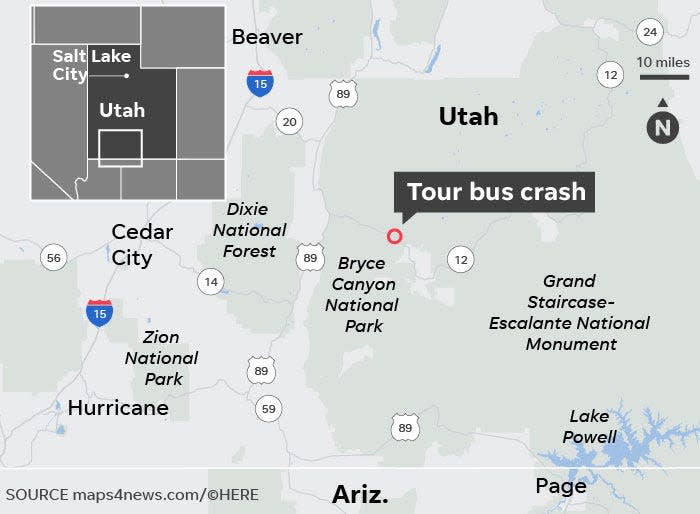Buckle up on a tour bus, experts say. But seat belts aren't always required
Travelers who take a bus tour might not think to do something they'd do automatically if they were getting into their own cars: buckle up.
At least four people were killed when a tour bus carrying 30 passengers crashed Friday near Utah's Bryce Canyon National Park. Authorities haven't yet said whether the the bus was equipped with seat belts or if the passengers were using them.
According to the National Highway Traffic Safety Administration (NHTSA), more than half of motorcoach fatalities result from occupant ejection, frequently during a rollover.
While authorities are still investigating the cause of the crash, initial photos of the crash site shared by the Utah Highway Patrol appear to show the bus rolled over, with its roof crushed into the passenger cabin.
The latest: At least 4 dead, multiple injured in Bryce Canyon tour bus crash
Just as seat belts have saved lives in passenger vehicles, they are effective in large buses as well, safety experts say.
"It’s undisputed that having seat belts saves lives," said Tim Loranger, a Los Angeles attorney who represents clients involved in transportation accidents.
The National Transportation Safety Board has recommended seat belts in large buses since 1971, citing a number of deadly crashes..
The Obama administration adopted a rule in 2013 requiring lap-and-shoulder restraints in all new motorcoaches manufactured after the end of 2016. It did not, however, require existing large buses to be retrofitted with similar restraints.
In 2014 the NHTSA proposed a rule requiring better structural integrity of large buses to better protect passengers in rollover crashes. More than five years later, the rule is not final.
Individual states have taken their own steps to improve bus passenger safety.
A California law that took effect last year requires all bus passengers age 16 or older traveling within the state to wear seat belts when the bus has them.
The bus involved in Friday's Utah crash is registered to company called America Shengjai, in Ontario, California.
According to U.S. Department of Transportation records, the company operates two buses, and neither have been involved in any crashes or have been cited for major safety violations. USDOT records show the buses travel in Utah, California and Arizona.
A New Jersey law enacted last year, following a fatal school bus crash, requires all school buses to be equipped with lap-and-shoulder restraints. Other states only require lap belts in school buses; some don't require seat belts at all.
"That should be a requirement for all these vehicles," Loranger said.
The cost, however, could be a barrier, especially for operators of small fleets.
In a 2016 report, the U.S. Department of Transportation projected that it would cost from $14,650 to $40,000 per vehicle to retrofit with lap-and-shoulder restraints.
"Money is a driving force behind the way a lot of these decisions are made," Loranger said.
The department's report concluded that the retrofits would produce little safety benefit if passengers didn't buckle up. Even in countries where seat belt use in passenger vehicles was as high as 90%, seat belt use in large buses was typically under 10%, the report said.

"It would be impractical to require retrofitting on older vehicles," the department concluded.
The severity of large bus crashes can be affected by a variety of factors, including the mechanical condition of the bus and the medical fitness of the driver, or weather and road conditions. An impaired, sleepy, distracted or unqualified driver can also contribute to the severity of a crash.
The NTSB announced Friday that it was sending a team to Utah to investigate the crash. While it typically takes the board at least a year to release its conclusions, it often provides detailed preliminary reports within days or weeks.
Though Congress and federal agencies consider its recommendations and adopt many of them, the NTSB has no power to enact or enforce changes in transportation safety.
"The buses are supposed to conform to whatever federal regulations exist," Loranger said.
Contributing: Robert Anglen and Bree Burkitt, Arizona Republic
This article originally appeared on USA TODAY: Bryce Canyon tour bus crash in Utah: Not all buses have seat belts

